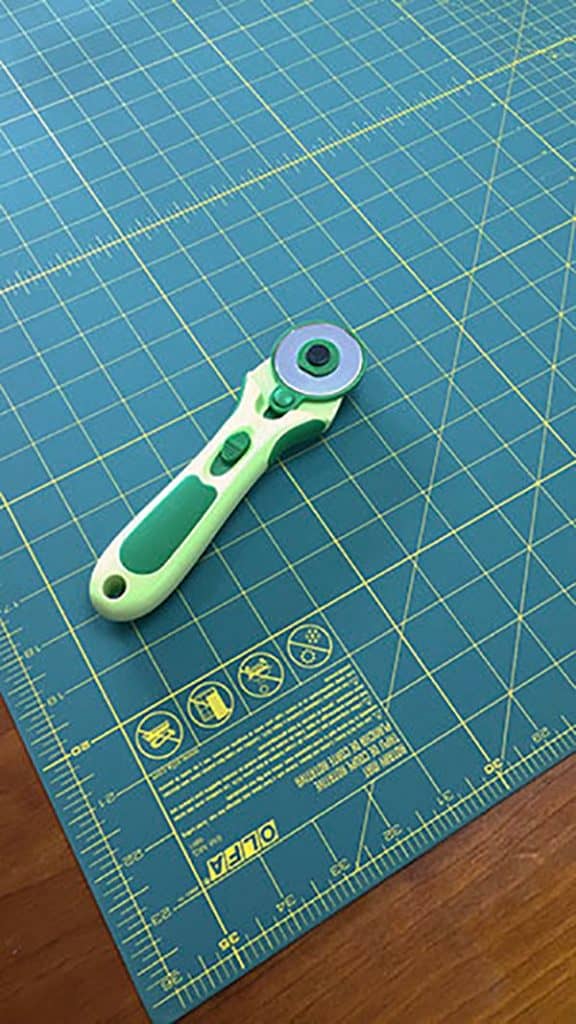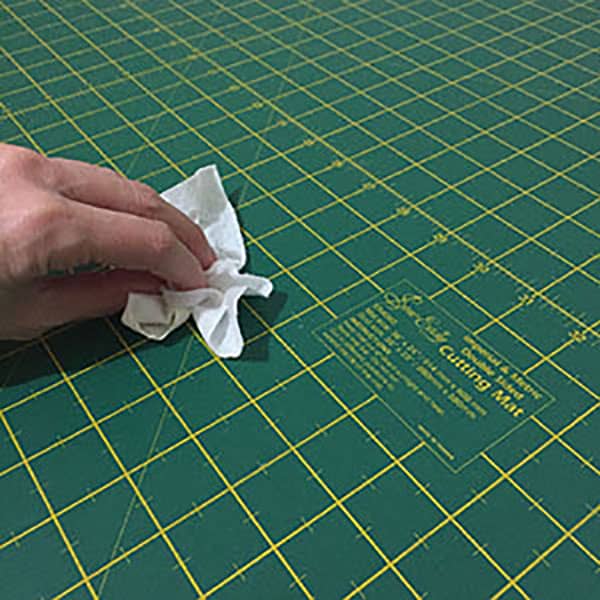Okay, so maybe the world wouldn’t end without cutting mats but it would be close. We’ve gotten so used to using these darned things it would be really difficult to give them up. I’m not sure I would want to go back to using scissors to cut all those itty bitty bits of fabric although I have great respect for you if you do.
Yes, we are spoiled these days but I am glad I am spoiled. The cutting mat is an amazing invention, along with the rotary cutter of course. It allows you to not only make more accurate cuts but also increases efficiency since you can cut more fabric in one go.
However, if you have been using cutting mats for a while then you know that they are not all created equally. Some are definitely better than others.
Our Favourite Cutting Mat
We have used a number of different brands over the years but the ones we like are Olfa (which is what we are using now) and another brand that we really like is Sew Easy.
A while ago we purchased a mat that was on special at a craft show, without taking a good look at it. The first time we came to use it we realised we had made a mistake with this purchase. It had inch markings along the top and centimetre marks along the bottom. Trying to match up the cutting lines wasn’t easy so that mat didn’t last long. It was a shame because otherwise it’s a really good mat.
You can see the mats we use here.
What to look for when buying a cutting mat
For starters, it needs to be self healing. Every time you make a cut with your rotary cutter you leave a groove on the mat. Over time these grooves may affect the accuracy of your cut, you may even catch your fabric and pull threads. A self healing mat is made so that the grooves close up after being cut by a blade, although over time if you keep cutting along the same line, the mat does have trouble healing and you can end up with a permanent groove so try to avoid cutting continually in the same place.
We have a separate mat for cutting batting as the fibers tend to get pushed down into the grooves. You can also just flip your mat over if you have a double sided mat and just use one side exclusively for cutting batting.
Size does matter!
Our best tip is to get the biggest cutting mat you can afford and have room for. It does make a difference when cutting as it leads to more accurate cuts because you don’t need to fold your fabric to fit on your mat.
We use a 24″ x 36″ mat. You can see it here.
The larger mats suit us as we work at home and we cut lots of yardage. But if you are limited with space, go to classes or your budget is limited, you may want to consider a smaller mat, perhaps something measuring around 18″ x 24″. Mats come in a variety of sizes and there are smaller mats and even fold up mats available for those small spaces and for when you are travelling.
Extending the Life of Your Mat
Yes, it’s designed to take abuse, after all you are running a sharp blade over it, however, there are things you can do to look after your mat.
Always make sure you are working with a sharp blade. Blunt blades won’t make a clean cut on your fabric and if you have to go back and forth to make your cut, this will eventually affect the mat. As we have already mentioned, it may cause a groove that your mat simply can’t heal.
Rotate your mat so that you aren’t cutting in the same area all the time. Spread the love so that your mat doesn’t have too much wear in one spot.
If you need to store your mat then if possible try to lay it flat or hang it against a wall when it’s not in use. This will stop it from warping. Most importantly, keep it away from heat and obviously don’t use your iron on it even if you have an ironing mat that you place over it. The heat will still get through and warp the mat…ask me how I know this.
How do we clean our mats?
This will depend on the mat. On our Sew Easy mat we use wet wipes as the mat has a smooth texture. Wet wipes are particularly good at cleaning up the fiber left after we have cut batting. I have seen others recommend an art eraser although we have never tried that ourselves as the wet wipe does the job for us.
Our Olfa mat is a different story. The wet wipes don’t work as the mat has a lightly rough texture and the fibres from the wet wipes are left on the mat. So we just use a damp cloth. Olfa themselves recommend using “a generous amount of room-temperature water and a few drops of mild detergent” and to gently scrub with a soft toothbrush.
Some even place their cutting mats in the bath tub and clean it with soapy water. I think this will depend on the type of mat you have as at least one person in a forum said that their mat fell to pieces when they did this. So it might only be worth doing this if your mat is so far gone that you are ready to toss it out anyway.




Leave a Reply